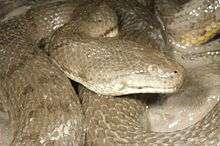Cerberus rynchops
| Cerberus rynchops | |
|---|---|
 | |
| Scientific classification | |
| Kingdom: | Animalia |
| Phylum: | Chordata |
| Class: | Reptilia |
| Order: | Squamata |
| Suborder: | Serpentes |
| Family: | Colubridae |
| Subfamily: | Homalopsinae |
| Genus: | Cerberus |
| Species: | C. rynchops |
| Binomial name | |
| Cerberus rynchops (Schneider, 1799) | |
| Synonyms | |
|
Cerebrus rhynchops | |
The New Guinea bockadam or dog-faced water snake, Cerberus rynchops, is a species of a colubrid snake found in coastal waters of Asia and Australia.
C. rynchops is commonly found in mangroves, mudflats, streams, ponds, tidal pools, on algae patches, and has even been found burrowing into the mud. C. rynchops is rear-fanged and is mildly venomous. An aquatic and nocturnal snake, it feeds mainly on fish and is known to consume eels.
In captivity, it is observed to move in a sidewinding direction on land. In the BBC series 'Life in Cold Blood' it was filmed adapting this sidewinding technique to jump across a mudflat in Singapore ( up until then no snakes were considered able to truly jump ). It also has a prehensile tail that would suggest it could climb mangrove trees. It is now known to give birth to live young, numbering from 8 to 30, either in water or on land.
It is a quite docile, mild-tempered and a hardy snake; in recent years it has become a welcome addition to snake hobbyists in the Philippines. It also owes its popularity to its bright yellow to orange belly coloring, mostly of females.

Description
The visibility of upper jaw, giving it a dog-like appearance. Head long and distinct from neck. Eyes small and beadly, with rounded pupil. Dorsum dark gray, with faint dark blotches and a dark line along the sides of the head, across the yes. Venter cream with two distinct rows of large, diffuse dark gray spots.
Scalation
Scales are distinctly keeled. Midbody scale rows 21-25. Ventrals 132-160. Subcaudals 49-72.
Distribution
This is a saltwater-tolerant species found in Australia (North Territory, Queensland, West Australia), New Guinea, Indonesia (Ambon, Babi, Bacan = Batjan, Bali, Bangka, Buru, Butung, Dolak, Enggano, Flores, Goram, Halmahera, Java, Kalimantan, Lombok, Mentawai Archipelago, Nako, Natuna Archipelago, Nias, Riau Archipelago, Roti, Sangihe Archipelago, Saparua, Seram, Simeulue, Singapore, Sulawesi, Sula Archipelago, Sumatra, Sumba, Sumbawa, Talaud Archipelago, Ternate, Timor, We, Western New Guinea, Wetar); Bangladesh, Cambodia, India (including Andaman and Nicobar Islands), Malaysia (Malaya and East Malaysia, including Pulau Tioman), Burma (Myanmar), Philippine Islands (including Palawan, Panay, Luzon), Singapore, Sri Lanka, Thailand and Vietnam. Race novaeguinea is found in Indonesia (western New Guinea). Type locality: "Ganjam" (Orissa State, SE India)
References
- ↑ Murphy, J (2009). "Cerberus rynchops". IUCN Red List of Threatened Species. Version 2011.1. International Union for Conservation of Nature.
- Boulenger, George A. 1890 The Fauna of British India, Including Ceylon and Burma. Reptilia and Batrachia. Taylor & Francis, London, xviii, 541 pp.
- Karns,D.R.; O'Bannon,A.; Voris,H.K. & Weigt,L.A. 2000 Biogeographical implications of mitochondrial DNA variation in the Bockadam snake (Cerberus rynchops, Serpentes, Homalopsinae) in Southeast Asia. J. Biogeography 27: 391–402
- Schneider, J. G. 1799 Historiae Amphibiorum narturalis et literariae. Fasciculus primus, continens Ranas. Calamitas, Bufones, Salamandras et Hydros. Jena, 266 S.
External links
- http://itgmv1.fzk.de/www/itg/uetz/herp/photos/Cerberus_rynchops.jpg
- http://itgmv1.fzk.de/www/itg/uetz/herp/photos/Cerberus_rynchops2.jpg
- http://itgmv1.fzk.de/www/itg/uetz/herp/photos/Cerberus_rynchops3.jpg
- http://itgmv1.fzk.de/www/itg/uetz/herp/photos/Cerberus_rynchops4.jpg
- http://itgmv1.fzk.de/www/itg/uetz/herp/photos/Cerberus_rynchops5.jpg
- http://itgmv1.fzk.de/www/itg/uetz/herp/photos/Cerberus_rynchops6.jpg
- http://www.wildsingapore.per.sg/discovery/factsheet/snakedogfaced.htm
- http://www.ecologyasia.com/verts/snakes/dog-faced_water-snake.htm
